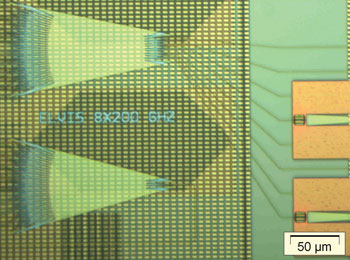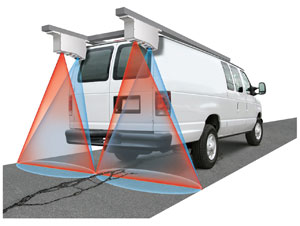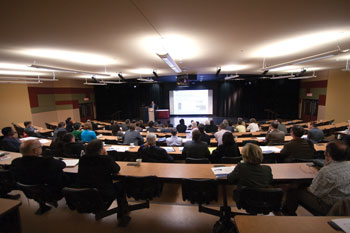By joining a regional organization of like-minded
entities – and, more importantly, by participating in their activities –
you will increase your standing as a technology company, according to leaders of
photonics clusters around the world. Further, you will be part of a feedback loop
of information and camaraderie that is not only self-sustaining, but also powerfully
synergistic.
Whereas national and international photonics organizations such
as the OSA and SPIE take all comers, clusters have self-selectively broken up the
industry into geographically relevant chunks, making it easier for member companies
to reach out to each other through frequent meetings and other events.
The benefits of membership
Cluster members are drawn from a variety of related entities,
including universities; government laboratories; service providers; interested individuals;
and large, medium and small companies representing the wide spectrum of photonics
technologies.

Clusters help facilitate the success of photonics technologies, such as this example of silicon
photonics showing an eight-channel arrayed waveguide grating with 8-Ge photodiodes
bonded on a CMOS circuit. Courtesy of Jean-Marc Fedeli, European Silicon Photonics
Cluster.
Clusters offer a range of benefits for joining, such as hosting
workshops, discussion panels and training sessions. They also act as advocates for
their members, representing the needs of optics and photonics industry players to
government agencies and legislators. The main purpose of clusters in their eyes
is to offer members as many networking opportunities as possible.
“We’re not trying to sell a product or an idea. We’re
more interested in getting members together to develop their own ideas,” said
Thomas Pearsall of EPIC, the European Photonics Industry Consortium. EPIC spans
17 nations and has about 80 member companies, research institutes, universities
and financial organizations located throughout Europe. The organization owns and
maintains the Photonic Technologies Roadmap and works with universities to train
students in addition to its member activities.

Pavemetrics Systems – a spinoff from Quebec Photonics Network member INO – has developed
a technology that makes it possible to acquire high-resolution road surface profiles
at speeds greater than 60 mph. Courtesy of Pavemetrics Systems.
The most important message the group tries to impress upon its
members, according to Pearsall, is: “We help you make money!” Last year,
he said, EPIC helped companies earn 11 times their annual membership fee. One way
the group helps is by connecting member companies with banks and individual investors.
EPIC also exposes members to the Nexpresso program (Network for
EXchange and PRototype Evaluation of photonicS componentS and Optical systems),
which began this year. Nexpresso has been organized to help small and medium-size
companies identify and advance beta projects, thus helping to commercialize their
novel technologies earlier than normal.
Actors and their roles
The keystones of activity in photonics clusters are the annual
meetings – quarterly in some cases – and informal events such as ball
games, picnics and clambakes. The number of members who turn up varies, and the
amount of buzz generated at each event may fluctuate, but most cluster representatives
report spirited participation. Formal or informal, these meetings are the best opportunity
for people to talk shop, to get to know new members and to work to gain a competitive
advantage.
The 13-year-old Colorado Photonics Industry Association offers
its members a side benefit: Meetings rotate among members, each one taking a turn
as host. According to the group’s president, David Giltner, this gives valuable
insight into their operations.
Startups are a prime example of a willing participant in a cluster
because they tend to have a lot of enthusiasm for gathering useful technical and
business knowledge.
“We have a better capability to attract startup and small
companies,” said Michel Têtu, president and CEO of the Quebec Photonic
Network. “They need a lot of support. When they start to grow, they have a
tendency to associate themselves with groups related to the main market they are
chasing.”

The Quebec Photonics Network sponsored a commemorative seminar on
the 50th anniversary of the laser and the invention of the CO2-TEA laser. It was
held at École de Technologie Supérieure in Montreal on May 14 this year.
Courtesy of the Quebec Photonics Network.
Small and young companies aren’t the only ones to turn to
clusters for help. When large companies experience huge shifts in their business,
individuals tend to be left to their own devices.
“After the telecom downturn, we lost a lot of momentum in
the province of Quebec due to Nortel and JDS-Uniphase shrinking,” Têtu
said. “The photonics people went then to other application fields, like imaging,
defense and security, remote sensing and medical, still maintaining some in the
telecom field. We have a total of about 100 companies using technologies for the
development of their products based on photonics. Today, we are trying to increase
participation in the cluster by stimulating sectorial subgrouping. This should increase
the number of possible company members.”
In Rochester, N.Y., Kodak went through its own turbulent times.
In time, both its small- and large-optics divisions were spun off into separate
companies. According to Wayne Knox, director of the University of Rochester’s
Institute of Optics and a board member of the Rochester Regional Photonics Cluster
(RRPC), both new companies have been very successful.
With the help and guidance of a community of photonics people,
nervous companies and employees alike can weather the storm. According to RRPC’s
president John Hart of Lumetrics Inc., Kodak went from 60,000 to 10,000 workers,
but the city’s photonics community absorbed the displaced people without too
many difficulties.
Despite any benefits of association, not all members participate
wholeheartedly. Even if they join a cluster, they may not partake in meetings or
conversations. They just don’t open up. This is true of one of the largest
clusters in the US, the Florida Photonics Cluster (FPC).
“[Some of our members are] concerned about competitive issues,”
said Alexandre Y. Fong, senior vice president of life sciences and instrumentation
at Gooch & Housego LLC and president of the FPC. “[We] need to let them
know it’s an opportunity to grow together.”
“The total number of paid-up members fluctuates a lot,”
Knox said. “Memberships in groups tend to go early during funding cuts at
companies.”
Philosophies and funding
Most photonics clusters are dedicated to the same guiding principles:
to accelerate the economic development of the photonics industry in their part of
the world, to help members advance their technologies as well as their business
savvy, and to be the voice of the industry for local, federal and business development
agencies, and for other clusters. In addition, they all tend to work to increase
the visibility of photonics technologies within their regions and beyond, to support
member companies’ sales and marketing efforts, and to facilitate their access
to market information.
The European Silicon Photonics Cluster is a little different from
most in that it is a meta-cluster comprising several Europe-based consortia, including
the one that hosts the cluster, Helios.
“The members are R&D projects in the field of silicon
photonics,” said cluster spokesman Jean-Marc Fedeli of France’s CEA-Léti,
a global research center committed to creating and commercializing innovation in
micro- and nanotechnologies. “Each project is a consortium of two to 20 partners.
Ten projects have joined for the creation of the cluster, and we intend to integrate
any new project.”
The silicon photonics group’s main purpose, according to
Fedeli, is to strengthen the dissemination activities of all its member projects,
in particular those activities aimed toward industrial players. Ultimately, the
cluster wants to provide additional visibility to each individual project as well
as to the technology of silicon photonics in general.
“It is of great interest for all the projects to join their
forces toward a common objective,” Fedeli said.
But who pays to make all those lofty goals become reality?
Funding is an ongoing struggle for many organizations. Membership
fees account for up to 80 percent of proceeds. Accounting for the rest are federal,
state and provincial governments; surplus cash left after cluster-organized events;
sponsorships; and grants from the National Science Foundation, the Small Business
Administration and similar organizations.
“We have no funding, per se,” said Michael Scott,
chairman of the Ottawa Photonics Cluster. “The city [government] provides
secretarial and in-kind help. Our meetings are sponsored. Other activities are self-funded.”
“We have a small budget and not too many people,”
agreed EPIC’s Pearsall.
Photonics’ future
Despite the general lack of a steady cash flow, the people behind
the clusters see an ongoing need to promote the virtues of photonics technology.
Most needed are investments and visibility. The general public needs to be made
aware of the role of photonics in their lives, and the positive aspects of a technical
industry must be constantly brought to the attention of local politicians and industry
titans alike.
“Photonics has become too broad, and it is often not seen
as the common issue between, say, an optical comms company and a biophotonics company,”
Scott said. “Better to focus on market sectors.”
According to the RRPC’s Knox, optics has an identity problem
that doesn’t affect just legislators. It tends to fall between the gaps of
scientific inquiry at the National Science Foundation and at similar funding agencies.
To correct this, the Rochester group is in talks with clusters in Arizona and Florida
to send a delegation to Washington in hopes of enlightening some minds there and
– perhaps – of opening some purse strings.
Within the industry itself, there are other problems that consistently
need attention. One is the dissemination of information between photonics companies
and their would-be partners both within and without.
“We need to facilitate the transfer of R&D results to
the industry,” said the European Silicon Photonics Cluster’s Fedeli.
“More publicity of the many resources available to photonics
companies in Florida and, particularly, the Central Florida 23-county region served
by the Florida High Tech Corridor Council,” said the FPC’s Wong.
No matter the target audience, nor how slowly the money trickles
in, the photonics clusters will continue to strengthen the industry to the benefit
of their (eagerly) participating members.